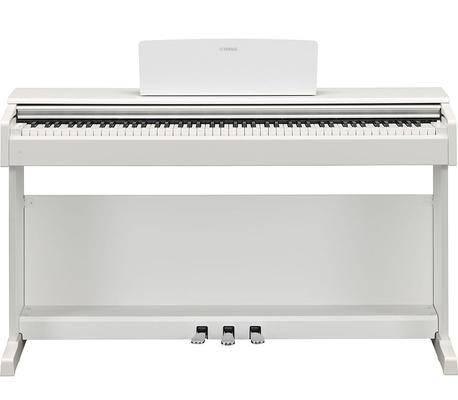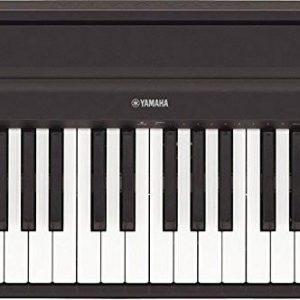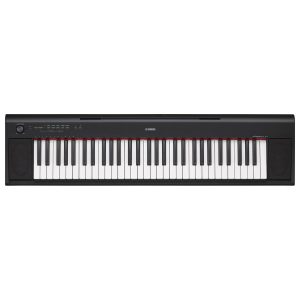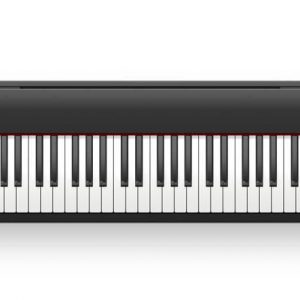Yamaha YDP-144
$599.99
The Yamaha YDP-144 piano blends classic design with modern technology to deliver an exceptional playing experience.
Compare
Description
The Yamaha YDP-144 is a digital piano that has been designed to offer the authentic touch and tone of an acoustic piano. This piano is perfect for beginners or for more advanced players who want to practice at home without disturbing others.
The YDP-144 features an 88-key Graded Hammer Standard (GHS) keyboard. This keyboard has been designed to provide a real-time response just like an acoustic piano. It is heavier at the low end and lighter at the high end, just like the keys on an acoustic piano. This means that the player will be able to practice their technique accurately, with a realistic feel.
The piano also features Yamaha’s Pure CF sound engine which produces the sound of a Yamaha CFIIIS concert grand piano. This sound engine provides a rich and detailed sound that is perfect for playing classical pieces, jazz, or any other genre of music. The YDP-144 also features a stereophonic optimizer, which allows the player to enjoy the sound of the piano even if they are using headphones.
The YDP-144 is also equipped with a number of different features that make it easy to use and convenient for practice. For instance, the piano has built-in metronome, transpose, and tuning functions. It also has a USB MIDI interface which makes it easy to connect to a computer or other device. This means that the player can easily record their performances, practice with a variety of different sounds, or learn how to play using educational software.
Another feature that makes the YDP-144 an excellent instrument for beginners is its Intelligent Acoustic Control (IAC) technology. This feature adjusts the loudness and balance of the piano based on how hard the player is striking the keys. This means that the player can practice at lower volume levels without sacrificing the quality of the sound.
The YDP-144 is an excellent choice for anyone who wants a digital piano that feels and sounds like an acoustic piano. It is well-suited for both beginners and more advanced players, and it provides a range of useful features that make it convenient to use and practice with. Overall, the Yamaha YDP-144 is a great investment for any pianist who wants to improve their skills from the comfort of their own home.
Yamaha YDP-144 properties
| Product name |
YDP-144 |
| Brand |
Yamaha |
| Type |
Keyboard Instruments |
| Keyboard Instrument |
Stage and Digital Piano |
| Keys |
Yes |
| Number of Keys |
88 pcs |
| Key Functions |
Dual Layer, Touch Sensitive, Weighted Keys |
| Pre-Programmed Songs |
Yes |
| Pre-Programmed Sounds |
Yes |
| Pre-Programmed Effects |
Yes |
| Speakers |
Yes |
| Supported Audio Files |
SMF |
| Connections |
Headphone, USB |
| Colour |
Black, White, Wood |
| Power Supply |
Electrical Cable to Wall Socket |
Frequently Asked Questions:
"What is the recommended maintenance routine for my Yamaha YDP-144 digital piano?"
Here's a recommended maintenance routine for your Yamaha YDP-144 digital piano:
1. Cleaning and Dusting: Regularly clean the exterior surface of the keyboard with a soft, dry cloth. Avoid using any liquid cleaners or abrasive materials that could damage the finish. Make sure to keep the area around the keyboard free from dust and debris.
2. Power Off Properly: Always turn off your digital piano when not in use and unplug it from the power outlet. This will help conserve energy, extend the life of the instrument, and reduce wear on internal components.
3. Keyboard Cleaning: Use a soft, damp cloth to gently clean the keys. Do not use any harsh chemicals or abrasive materials that could damage the key surfaces. For stubborn stains, you can use a small amount of mild soap diluted in water. Make sure to rinse and dry the keys thoroughly after cleaning.
4. Headphones Care: If you use headphones with your digital piano, make sure they are clean and free from dust or debris. Store them properly when not in use to prevent damage.
5. Keyboard Cover: Consider investing in a keyboard cover to protect your instrument from dust, dirt, and accidental spills. This will help maintain the appearance and performance of your digital piano for years to come.
6. Regular Tuning: While digital pianos are designed with built-in pitch stabilizers, they may still require occasional tuning. Yamaha recommends having your YDP-144 tuned by a professional technician every two years or as needed.
7. Software Updates: Keep your digital piano up-to-date by installing the latest software updates provided by Yamaha. These updates can improve performance, add new features, and address any known issues with your instrument.
8. Storage: When not in use, store your digital piano in a cool, dry place away from direct sunlight or extreme temperature changes. This will help protect the internal components and prolong the life of your instrument.
9. Regular Inspection: Conduct regular inspections of your digital piano to identify any potential issues before they become major problems. Check for loose connections, damaged cables, or any other signs of wear and tear that could affect the performance of your instrument.
10. Professional Service: Have your Yamaha YDP-144 serviced by a qualified technician at least once every three years to ensure optimal performance and longevity. This includes cleaning the interior components, inspecting all hardware, and making any necessary adjustments or repairs.
What are the unique features of the Yamaha YDP-144 digital piano, specifically addressing its suitability for stage performances?
The Yamaha YDP-144 digital piano boasts several distinctive qualities that make it an exceptional choice for stage performances. Firstly, this instrument delivers a powerful and dynamic sound output through its 6 Watts x 2 amplifiers, ensuring that every note is heard clearly even in large venues. Its AWM Stereo Sampling technology ensures that the sound quality remains rich and authentic, adding to the overall listening experience for both the performer and the audience. Furthermore, the YDP-144's compact design makes it highly portable and easy to transport from one location to another. This feature is especially beneficial when performing in multiple venues or traveling between gigs. Additionally, its lightweight construction ensures that it can be quickly set up on stage without taking up too much space. Another unique feature of the YDP-144 digital piano for stage performances is its compatibility with various MIDI devices such as synthesizers and drum machines. This allows performers to incorporate a variety of sounds into their performance, creating a more dynamic and engaging experience for the audience. Moreover, the YDP-144 comes equipped with an adjustable music rest that can be positioned at different heights to suit the performer's preference. This is particularly useful during live performances as it allows for clear visibility of sheet music or lyrics, enhancing the overall performance experience. Finally, the YDP-144 digital piano has a built-in metronome feature that helps performers keep time and improve their rhythmic accuracy. This feature is essential when playing in a group or with other musicians as it ensures synchronization between all performers. In conclusion, the Yamaha YDP-144 digital piano's powerful sound output, portability, compatibility with MIDI devices, adjustable music rest, and built-in metronome feature make it an ideal choice for stage performances. Its unique features ensure that the performer delivers a high-quality performance while providing a rich listening experience for the audience.
How does the Virtual Resonance Modeling technology in the Yamaha YDP-144 enhance the sound quality of this digital piano?
The Virtual Resonance Modeling (VRM) technology in the Yamaha YDP-144 enhances the sound quality by creating a rich and resonant tone that is true to the sound produced by an acoustic grand piano. This technology analyzes the behavior of strings and vibrations within an acoustic piano and recreates it in a digital environment, resulting in a more natural and lifelike sound. The VRM technology also allows for smoother transitions between notes and adds depth and richness to the overall tone, making the Yamaha YDP-144 an excellent choice for those who demand the highest level of realism and sound quality from their digital piano.
What is the optimal method for adjusting the sensitivity of the Yamaha YDP-144's hammer action to accurately match the dynamics of a traditional acoustic piano?
Adjusting the sensitivity of the Yamaha YDP-144's hammer action requires some trial and error, but here's a step-by-step guide to help you achieve an optimal setting that matches the dynamics of a traditional acoustic piano:
1. Familiarize yourself with the keyboard**: Play around with the keys to get a feel for how they respond. Notice how quickly they rebound after being struck, as well as their overall sensitivity. Identify the hammer action's adjustment points**: Locate the hammer action's adjustment points, usually found near the front of the piano or within the keybed. These may be labeled as "hammer felt hardness" or similar. Adjust the hammer action in small increments**: Gradually increase or decrease the hammer action's sensitivity by turning the adjustment dials or sliders. Start with small adjustments and listen to how the piano responds. Monitor the dynamics**: Play a range of dynamic levels, from pianissimo (very soft) to fortissimo (very loud). Pay attention to how the keys feel under your fingers and the overall response of the piano. Use reference materials**: Compare your playing to recordings or live performances on acoustic pianos. This will help you gauge whether your adjustments are yielding a more realistic dynamic range. Consider the type of music**: Different genres may require different settings. For example, classical music often requires a more delicate touch, while jazz and rock might demand a more robust feel. Record and compare**: Record yourself playing at various sensitivity levels and compare the recordings to those made on an acoustic piano or to reference tracks. This will help you identify if your adjustments are yielding a more realistic dynamic range. Make fine-tuned adjustments**: Based on your observations, make further adjustments to the hammer action's sensitivity until you feel that it accurately represents the dynamics of a traditional acoustic piano.
Before you buy Yamaha YDP-144






Kayden –
I’d give the Yamaha YDP-144 a solid 3 out of 5, it’s not perfect, but it’s a great option for those on a budget, like me, who don’t want to end up back in the digital piano jail like those Scottish prisoners.
Okay, let me get into it.
Setting up the Yamaha YDP-144 was pretty straightforward, I mean, how hard can it be to set up a digital piano, right? But seriously, I did encounter one problem – the Stage and Digital Piano settings just wouldn’t sync for some reason. It was driving me crazy! But then I stumbled upon this great YouTube video that showed me how to reset the factory defaults on the piano, and voila! Problem solved.
But let’s talk about the Power Supply on the Yamaha YDP-144 – it’s a simple electrical cable that plugs into your wall socket. Now, you’d think that would be enough, but trust me, it can affect the performance of the digital piano in some pretty wild ways. I mean, imagine if you were trying to play a beautiful Chopin nocturne and suddenly the notes start sounding like a bag of cats fighting – yeah, that’s what happened to me once.
But anyway, why did I choose Yamaha YDP-144? Well, for one thing it’s affordable – it won’t break the bank like some of those other digital pianos out there. And two, it’s got all the features you need as an amateur (or even a professional) musician, including weighted keys and USB connectivity.
Now, let’s compare amateur and professional use of Yamaha YDP-144. For amateurs, this piano is perfect – it’s easy to set up, sounds great, and won’t break the bank. But for professionals? Well, I’ve seen some of those guys using this thing on stage and they just make it look effortless.
But let me tell you one thing that really cracked me up – have you heard about the Scottish prisoners who got caught back in jail within weeks of being released? Like 57 prisoners! What is going on there?! It’s like they’re trying to play a game of digital piano roulette or something.